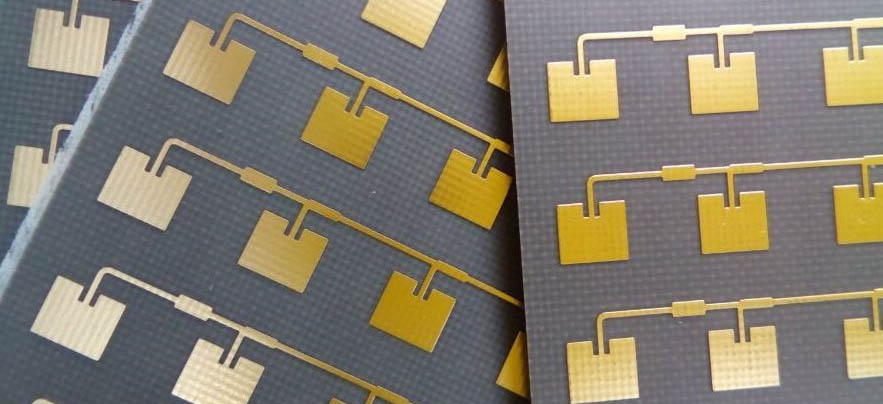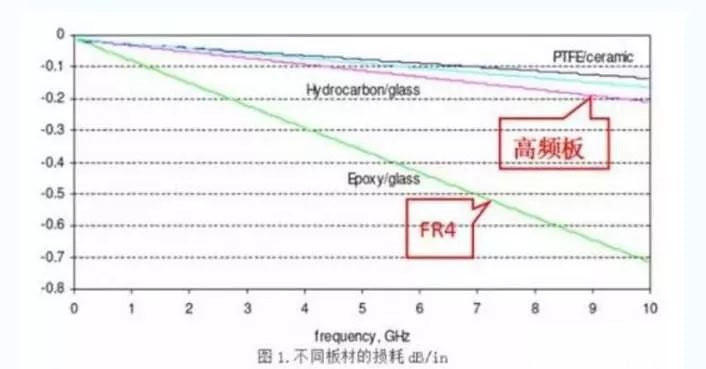As more and more equipment designs are in the microwave frequency PCB board, how to choose high-frequency and high-speed PCB substrate materials is becoming more and more important. For example, the frequencies of the lively 77GHz millimeter wave antennas on vehicles are getting higher and higher, and the requirements for PCB substrate materials are also getting higher and higher. For example, the PCB substrate material needs to have excellent electrical properties, good chemical stability, and the loss on the substrate with the increase of the power signal frequency is very small, so the importance of the high-frequency PCB substrate material has emerged.
Classification of high frequency and high speed PCB substrate materials
1. Classified by high frequency PCB material
a. Organic material: Phenolic resin, glass fiber/epoxy resin, Polyimide, BT/Epoxy, etc. are all included.
b. Inorganic materials: aluminum, Copper-invar-copper, ceramic, etc. are all of them. Mainly take its heat dissipation function
2. Classification by PCB product soft and hard
a. Rigid PCB.
b. Flexible PCB.
c. Rigid-Flex PCB.
3. Classified by PCB structure
a. Single PCB board
b. Double PCB board
c. Multilayer PCB board
4. Classification by PCB use
Communication/expendable electronics/military/computer/semiconductor/ic test board...

high-frequency PCB substrate material
Commonly used high-frequency and high-speed PCB substrate material manufacturers
1. Rogers
RO4003C, RO3003, RO4350B, rogers 5880, etc.
RO3000 series: Based on ceramic-filled PTFE circuit materials, the models are: RO3003, RO3006, RO3010, RO3035 high-frequency laminates.
RT6000 series: Based on ceramic-filled PTFE circuit materials, designed for electronic circuits and microwave circuits that require high dielectric constants. The models are: RT6006 dielectric constant 6.15, RT6010 dielectric constant 10.2.
TMM series: composite materials based on ceramics, hydrocarbons, and thermosetting polymers, models: TMM3, TMM4, TMM6, TMM10, TMM10i, TMM13i. and many more
2. Taconic
TLX series, TLY series, tly-3, tly-5, tly-7, tly-8, tly-9, rf-35, etc.
3. Panasonic
Megtron4(M4), Megtron6(M6), etc.
4. Isola
isola 370hr, fr408hr, IS620, IS680, etc.
5. Nelco
N4000-13, N4000-13EPSI, etc.
6. TaiYao TUC
Tuc862, 872SLK, 883, 933, etc.
Dongguan Shengyi, Taizhou Wangling, Taixing Microwave, Changzhou Zhongying, etc.
Of course, there are many other high-frequency plates that are not listed one by one. Among them, Arlon (which has been acquired by Rogers and is also an old brand radio frequency microwave material factory).

Select important indicators of high-frequency and high-speed PCB substrate materials
When selecting the substrate used for the PCB used in the high-frequency circuit, special consideration should be given to the change characteristics of the material DK at different frequencies. As for the requirements of high-speed circuit transmission or characteristic impedance control, the focus is on DF and its performance under the conditions of frequency, temperature and humidity.
General high-frequency and high-speed PCB substrate materials show the law of large changes in DK and DF values under the condition of frequency changes. Especially in the frequency from 1 MHz to 1 GHz, their DK and DF values change more obviously. For example, a general epoxy resin-glass fiber cloth-based substrate material (general FR-4) has a DK value of 4.7 at a frequency of 1 MHz, and a change of DK value of 4.19 at a frequency of 1 GHz. Above 1GHz, the change trend of its DK value is gentle. The change trend is that as the frequency increases, it becomes smaller (but the change is not large). For example, at l0GHz, the DK value of FR-4 is 4.15. The substrate material with high-speed and high-frequency characteristics changes in frequency. In the case of, the change of DK value is small, and the change of DK is mostly kept in the range of 0.02 under the changing frequency from 1MHz to 1GHz. Its DK value tends to decrease slightly under different frequency conditions from low to high.
The dielectric loss factor (DF) of general high-frequency and high-speed PCB substrate materials is affected by frequency changes (especially changes in the high-frequency range) and the change in DF value is greater than that of DK. The law of its change tends to increase. Therefore, when evaluating the high-frequency characteristics of a substrate material, the focus of its investigation is the change of its DF value. For substrate materials with high-speed and high-frequency characteristics, in terms of changing characteristics at high frequencies, there are two distinct types of general substrate materials: one is that with the change of frequency, its (DF) value changes very little . There is another type that is similar to the general substrate material in the range of change, but its own (DF) value is lower.
How to choose high-frequency and high-speed PCB substrate materials
Choosing high-frequency and high-speed PCB substrate materials must strike a balance between meeting design requirements, mass production, and cost. Simply put, design requirements include electrical and structural reliability. Usually in the design of very high-speed PCB boards (frequency greater than 1GHz), this high-frequency high-speed PCB substrate material problem will be more important. For example, the commonly used FR-4 material now has a large dielectric loss Df (Dielectricloss) at a frequency of several GHz, which may not be suitable for high-frequency and high-speed PCB substrate materials.